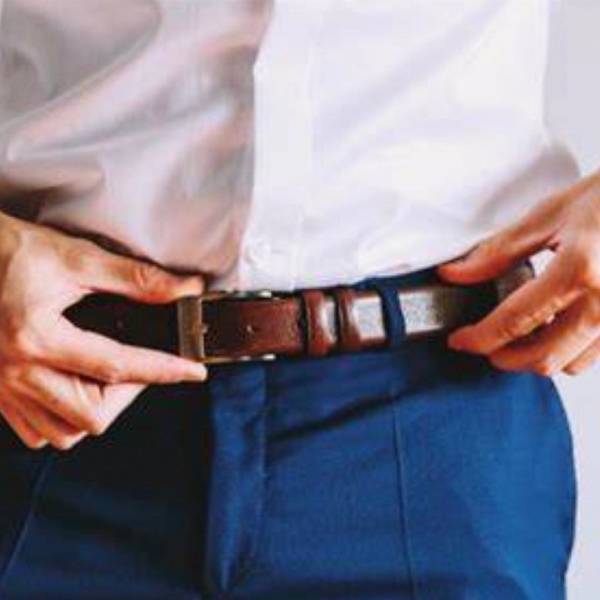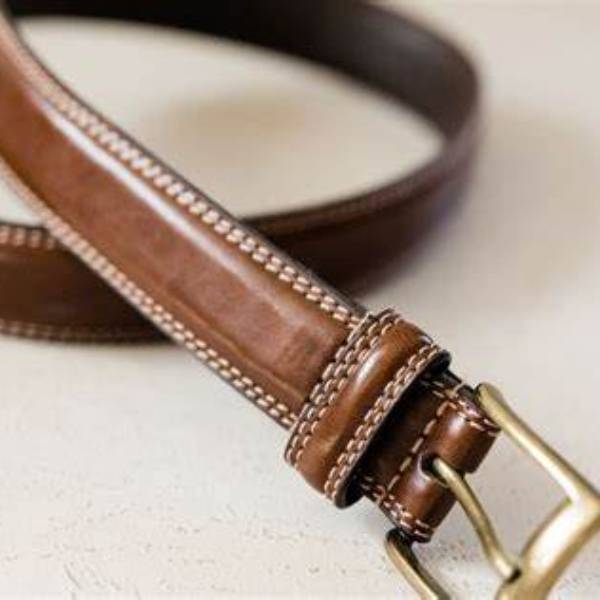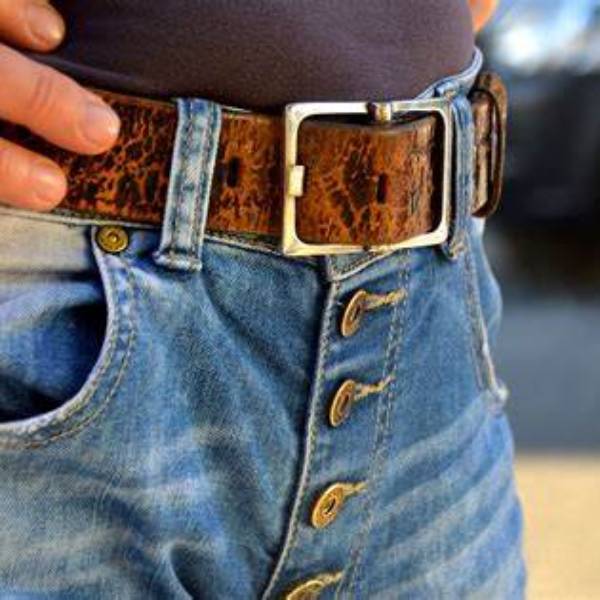Measure Your Waist for Belt Sizing
To find out ‘what size belt am I’, measuring your waist is a crucial step. Here’s a simple guide to do it right:
- Find a flexible tape measure that you can wrap around your waist.
- Wear your trousers at the level you normally do, because this affects where the belt sits.
- Locate your waist or where you usually wear your belt. This might not be your actual waistline, but rather just above your hips.
- Wrap the tape measure around that part snugly without squeezing your skin. The tape should not be loose.
- Read the measurement where the tape meets the zero mark. Consider rounding up to the nearest inch if you’re between sizes.
Always measure while standing up straight and breathing normally. Don’t hold your breath or suck in your stomach – you want the most accurate measurement to ensure comfort, especially if you’ll be sitting down a lot.

It is also a good idea to take multiple measurements over a few days. This accounts for any variability, giving you a more reliable size to work with. Once you’ve got your measurement, you can proceed to understand how it translates to belt size.
Understanding Belt Sizing: An Overview
When you ask ‘what size belt am I’, you need to understand belt sizing. Belt sizes appear complex, but they’re simple once you know the basics. A belt size indicates the length of the belt from the buckle to the middle hole. This is where you should wear it for the best fit. Generally, men’s belts range from size 28 to 44 inches. Women’s belts often come in small, medium, and large sizes.
Belts provide both function and style. To pick the right one, you should match the belt size with your waist measurement. But there’s a catch – your belt size isn’t the same as your pant size. A rule of thumb is to add two to three inches to your pant size. This ensures the belt fits properly around your waist and through your pant loops. Choosing the right belt is crucial for style and comfort, and if you need to customize the fit, knowing how to punch a hole in a belt can help you adjust it perfectly to your size.
For example, if your waist measures at 34 inches, start with a size 36 or 38 belt. Trying on belts is an excellent practice if you can. This way, you learn how different brands size their belts. Leather belts might give a little over time while synthetic materials tend to hold their shape. Choose a belt material based on your preference and the amount of stretch you expect.
Now that you’ve got the basics of belt sizing, measure your waist as described previously. Then add the necessary inches to find ‘what size belt am I’. Keep this overview in mind, and you’ll select the correct belt size with ease.
Tips for Accurately Measuring Belt Size
Correct belt measurement ensures the best fit. Here are some additional tips to accurately measure your belt size:
- Stand Up Straight: Your posture impacts your waist measurement. Stand tall for the most precise reading.
- Don’t Use Your Old Belt: Resist the temptation to measure an old belt. Belts can stretch over time, which might lead to an incorrect size.
- Record Measurements After Meals: Your waist size can vary before and after eating. Measure afterwards for a size that accommodates natural changes.
- Use the Right Tape: Ensure the tape measure is for clothing, not construction. It should be soft and flexible.
- Consider the Buckle: The belt size accounts for the strap only. But the buckle adds length. Keep this in mind especially when looking at belts with large buckles.
When followed, these tips will help you answer the question ‘what size belt am I’ with confidence and ease, ensuring you find a belt that fits well and feels comfortable. By applying these tips, you can confidently determine your size and select the perfect fit for an RM Williams belt, ensuring both comfort and style wherever you go.
How Belt Sizes Correspond to Pant Sizes
Understanding how belt sizes relate to pant sizes is key. The key lies in a simple conversion: add two to three inches to your pant size for the right belt fit.
- Know the Rule: For most, the belt size will be about two to three inches larger than the pant size. This accounts for the extra material from the pants and a comfortable fit.
- Check Brand Sizing: Some brands may vary, so it’s smart to check their sizing charts. They can guide you to make the correct choice.
- Men vs. Women: Men’s belts typically use inches, while women’s belts come in standard small, medium, and large. Understand these differences when selecting.
- Consider the Fit: Want a snug fit? Go closer to two inches. Prefer room? Three inches is your bet.
- Mind the Material: Leather belts stretch slightly, so you might opt for a tighter size. Synthetic materials less so.
Keep these points in mind, and you’ll avoid common pitfalls when trying to answer ‘what size belt am I’ in relation to your pant size.

Choosing the Right Belt Type for Your Body
When selecting a belt, consider your body type. Belts are not just functional; they can flatter your frame when chosen correctly. Here are things to keep in mind:
- For a Slimmer Look: Choose a narrow belt if you’re aiming for a slimmer appearance. Thin belts highlight the waist without adding bulk.
- To Enhance Curves: If you have a curvier figure, a medium-width belt worn at the smallest part of your waist can enhance your shape.
- For Tall Individuals: If you’re tall, you can go for wider belts. They provide proportion and can be a statement piece.
- Consider Belt Placement: High-waist belts can create an hourglass effect, while belts worn lower can elongate the torso. Think about what features you’d like to accentuate.
- Avoid Over-Accessorizing: A belt should complement your outfit, not overwhelm it. Stick to simpler designs if your outfit is already busy.
Remember, the right type of belt does wonders for your outfit and can enhance your body’s strengths. Keep in mind your own comfort and the look you’re aiming for when asking ‘what size belt am I’.
Adjusting Belt Size for Weight Fluctuation
Weight fluctuation is common, and your belt size may change with it. Here are some suggestions for maintaining a perfect fit throughout your weight changes:
- Choose Adjustable Belts: Look for belts with multiple holes or a sliding mechanism. These features help you tighten or loosen your belt easily.
- Invest in a Hole Puncher: If you love a belt that’s now too big, a leather hole puncher can add more holes for a better fit.
- Keep Several Sizes: Keep belts in various sizes. This way, you have options if your weight changes.
- Go for Elastic Belts: Elastic belts are flexible and can adjust to your size automatically.
- Consider Reversible Belts: Reversible belts often allow for adjustments. They also offer style versatility.
- Know When to Size Up or Down: If you’ve lost weight, you might need a smaller belt. Gained weight? A larger size may be needed.
- Use Temporary Solutions: For minor fluctuations, temporary extenders or clips can make your belt fit better.
Remember, comfort is key. Make sure your belt fits well and feels comfortable, no matter your weight. This ensures you look and feel your best every day.

Common Mistakes to Avoid When Determining Belt Size
Avoiding errors when figuring out ‘what size belt am I’ is crucial for a good fit. Here are mistakes to steer clear of:
- Ignoring the Width: Don’t just focus on the length. The belt’s width is also important for fit and style.
- Forgetting the Buckle: Belt sizes often exclude the buckle. Remember to consider its size, especially with larger designs.
- Overlooking Stretch: Leather belts can stretch. Take this into account and maybe choose a snugger fit.
- Using Pant Size: Your pant size is not your belt size. Always add two to three inches to your pant size.
- Guessing the Size: Never guess your belt size. Measure your waist as described earlier to avoid mistakes.
- Neglecting Brand Variations: All brands size differently. Check their sizing charts for accuracy.
- Skipping the Try-On: If possible, always try on belts. This ensures the size aligns with your comfort and style needs.
By keeping these mistakes in mind, you can make an informed choice and find the perfect belt size for you.
Where to Shop for Belts Once You Know Your Size
Once you’ve calculated ‘what size belt am I’, shopping for belts becomes a breeze. Here are some places to start:
- Department Stores: They offer a variety of brands and styles, letting you compare sizes and fits.
- Leather Goods Stores: Specialized shops often provide high-quality options and may offer sizing advice.
- Online Retailers: Convenient and vast, online stores like Amazon have a wide range of sizes. Always check their return policies.
- Clothing Boutiques: For unique and fashionable belts, boutique stores may have exclusive designs.
- Flea Markets or Craft Fairs: Handcrafted belts might be available here, with artisans often providing custom sizing.
- Thrift Stores: You can find affordable and diverse belt options, possibly even vintage finds.
When shopping, remember to keep your exact waist measurement and preferred style in mind. This way, not only do you ensure a proper fit, but you also select a belt that complements your wardrobe and personal taste. Look out for sales and promotions to grab the best deal on your perfect belt! When you’re considering a cognac leather belt, make sure to take your waist measurement and preferred style into account, as this will help you find the perfect accessory that not only fits well but also enhances your overall look. Don’t forget to keep an eye out for sales to snag a great deal!



